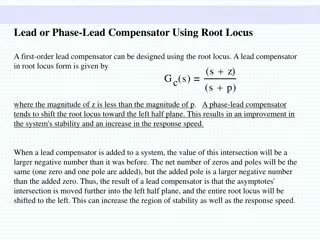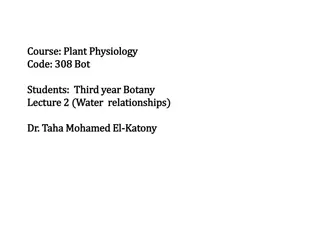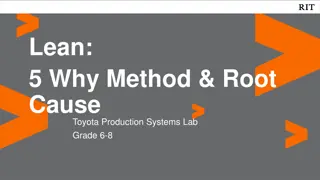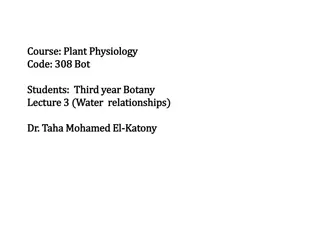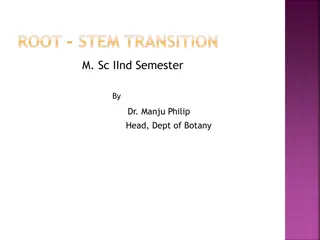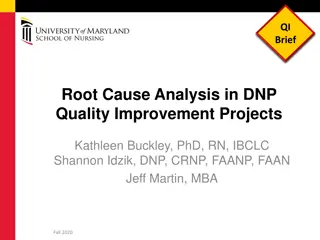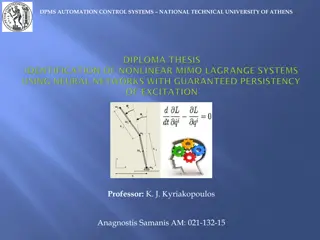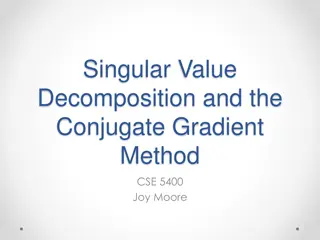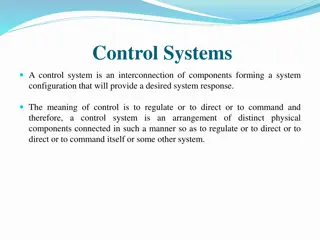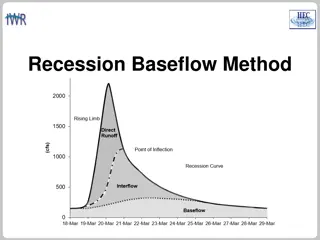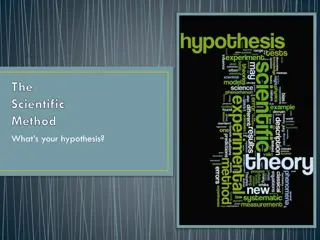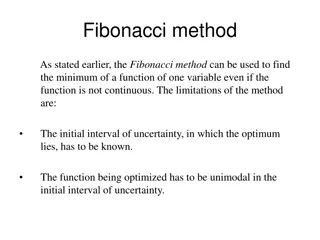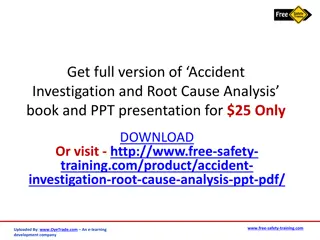Understanding Root Locus Method in Control Systems
The root locus method in control systems involves tracing the path of roots of the characteristic equation in the s-plane as a system parameter varies. This technique simplifies the analysis of closed-loop stability by plotting the roots for different parameter values. With the root locus method, designers can predict how changes in system parameters affect the location of closed-loop poles, aiding in the design of stable control systems.
Download Presentation

Please find below an Image/Link to download the presentation.
The content on the website is provided AS IS for your information and personal use only. It may not be sold, licensed, or shared on other websites without obtaining consent from the author. Download presentation by click this link. If you encounter any issues during the download, it is possible that the publisher has removed the file from their server.
E N D
Presentation Transcript
Digital and Non-Linear Control Root Locus
Outline Introduction Angle and Magnitude Condition Construction of Root Loci Examples
Introduction Consider a unity feedback control system shown below. K (s ) (s ) C R + 1 s The open loop transfer function G(s) of the system is 1 + K =s ( ) G s And the closed transfer function is ( ) ( ) C s G + s K 1 = = + + ( ) 1 ( ) R s G s s K
Introduction Location of closed loop Pole for different values of K (remember K>0). s C = ) ( K Pole ( ) K 1 + + Pole-Zero Map R s s K 1 0.5 1 -1.5 -2 0.5 Imaginary Axis 2 -3 0 3 -4 5 -6 -0.5 10 -11 15 -16 -16 -14 -12 -10 -8 -6 -4 -2 Real Axis
What is Root Locus? The root locus is the path of the roots of the characteristic equation traced out in the s-plane as a system parameter varies from zero to infinity.
How to Sketch root locus? One way is to compute the roots of the characteristic equation for all possible values of K. K Pole 0.5 -1.5 1 -2 ( ) C s K 1 = 2 -3 + + ( ) R s s K 3 -4 5 -6 -11 10 15 -16
How to Sketch root locus? Computing the roots for all values of K might be tedious for higher order systems. K Pole ? 0.5 1 ? ( ) C s K = 2 ? + + + + ( ) ( 1 )( 10 )( 20 ) R s s s s s K 3 ? 5 ? ? 10 15 ?
Construction of Root Loci Finding the roots of the characteristic equation of degree higher than 3 is laborious and will need computer solution. A simple method for finding the roots of the characteristic equation has been developed by W. R. Evans and used extensively in control engineering. This method, called the root-locus method, is one in which the roots of the characteristic equation are plotted for all values of a system parameter.
Construction of Root Loci The roots corresponding to a particular value of this parameter can then be located on the resulting graph. By using the root-locus method the designer can predict the effects on the location of the closed-loop poles of varying the gain value or adding open-loop poles and/or open-loop zeros.
Angle & Magnitude Conditions In constructing the root loci angle and magnitude conditions are important. Consider the system shown in following figure. The closed loop transfer function is ( ) ( s ) H C s G s = + ( ) 1 ( ) ( ) R s G s
Construction of Root Loci The characteristic equation is obtained by setting the denominator polynomial equal to zero. + = 1 ( ) ( ) 0 G s H s Or = ( ) ( ) 1 G s H s Since G(s)H(s) is a complex quantity it can be split into angle and magnitude part.
Angle & Magnitude Conditions The angle of G(s)H(s)=-1 is = ( ) ( ) 1 G s H s = 180 ) 1 + ( ) ( ) 2 ( G s H s k Where k=1,2,3 The magnitude of G(s)H(s)=-1 is = ( ) ( ) 1 G s H s = ( ) ( ) 1 G s H s
Angle & Magnitude Conditions Angle Condition G = 180 ) 1 + 3 , 2 , 1 = ( ) ( ) 2 ( ( ...) s H s k k Magnitude Condition = ( ) ( ) 1 G s H s The values of s that fulfill both the angle and magnitude conditions characteristic equation, or the closed-loop poles. are the roots of the
Construction of root loci Step-1: The first step in constructing a root-locus plot is to locate the open-loop poles and zeros in s-plane. Pole-Zero Map 1 0.5 Imaginary Axis 0 K = -0.5 ( ) ( ) G s H s + + ( 1 )( ) 2 s s s -1 -5 ( -4 -3 -2 -1 0 1 2 ) 1 + + The angle is ( ) 2 s s s Real Axis
Construction of root loci Step-2: Determine the root loci on the real axis. To determine the root loci on real axis we select some test points. e.g: p1 (on positive real axis). Pole-Zero Map 1 0.5 Imaginary Axis p1 0 The angle condition is not satisfied. -0.5 Hence, there is no root locus on the positive real axis. -1 -5 -4 -3 -2 -1 0 1 2 Real Axis
Construction of root loci Step-2: Determine the root loci on the real axis. Next, select a test point on the negative real axis between 0 and 1. Then Pole-Zero Map 1 0.5 Imaginary Axis Thus p2 0 The angle condition is satisfied. Therefore, the portion of the negative real axis between 0 and 1 forms a portion of the root locus. -0.5 -1 -5 -4 -3 -2 -1 0 1 2 Real Axis
Construction of root loci Step-2: Determine the root loci on the real axis. Now, select a test point on the negative real axis between -1 and 2. Then Pole-Zero Map 1 0.5 Imaginary Axis p3 Thus 0 -0.5 The angle condition is not satisfied. Therefore, the negative real axis between -1 and 2 is not a part of the root locus. -1 -5 -4 -3 -2 -1 0 1 2 Real Axis
Construction of root loci Step-2: Determine the root loci on the real axis. Pole-Zero Map Similarly, test point on the negative real axis between -2 and satisfies the angle condition. 1 0.5 Imaginary Axis p4 0 Therefore, the negative real axis between -2 and is part of the root locus. -0.5 -1 -5 -4 -3 -2 -1 0 1 2 Real Axis
Construction of root loci Step-2: Determine the root loci on the real axis. Pole-Zero Map 1 0.5 Imaginary Axis 0 -0.5 -1 -5 -4 -3 -2 -1 0 1 2 Real Axis
Construction of root loci Step-3: Determine the asymptotes of the root loci. That is, the root loci when s is far away from origin. Asymptote is the straight line approximation of a curve Actual Curve Asymptotic Approximation ? ? ???????? ?? ?????????? ????? ?? ??????????
Construction of root loci Step-3: Determine the asymptotes of the root loci. 2 ( + 180 ) 1 k = = of asymptotes Angle n m where n-----> number of poles m-----> number of zeros K For this Transfer Function = ( ) ( ) G s H s + + ( 1 )( ) 2 s s s ? ? ?(? + 1)(? + 2) ?????? ?? ????? ????????? ?? 3 ? + 1 = 180 (2? + 1) ? + 13? ?? ? ?? ?????, ) 1 + 180 2 ( k = 3 0
Construction of root loci Step-3: Determine the asymptotes of the root loci. ) 1 + 180 2 ( k = whe = = 60 n 0 k 3 0 = 180 when = 1 k = 300 when = 2 k = 420 when = 3 k Since the angle repeats itself as k is varied, the distinct angles for the asymptotes are determined as 60 , 60 , and 180 .
Construction of root loci Step-3: Determine the asymptotes of the root loci. Before we can draw these asymptotes in the complex plane, we need to find the point where they intersect the real axis. Point of intersection of asymptotes on real axis (or centroid of asymptotes) is poles zeros = n m
Construction of root loci Step-3: Determine the asymptotes of the root loci. K = For ( ) ( ) G s H s + + ( 1 )( ) 2 s s s ? ? ?(? + 1)(? + 2) ?????? ?? ????? ????????? ?? 3 ? + 1 = 180 (2? + 1) ? + 13? ?? ? ?? ?????, 0 ( 1 ) 2 0 = 3 0 3 = = 1 3
Construction of root loci Step-3: Determine the asymptotes of the root loci. Pole-Zero Map 1 0.5 = , , 60 60 180 Imaginary Axis 180 60 0 = 1 60 -0.5 -1 -5 -4 -3 -2 -1 0 1 2 Real Axis
Construction of root loci Step-4: Determine the breakaway/break-in point. Pole-Zero Map 1 The breakaway/break-in point is the point from which the root locus branches leaves/arrives real axis. 0.5 Imaginary Axis 0 -0.5 -1 -5 -4 -3 -2 -1 0 1 2 Real Axis
Construction of root loci Step-4: Determine the breakaway point or break-in point. The breakaway or break-in points can be determined from the roots of (page 275) 0 = ds dK It should be noted that not all the solutions of dK/ds=0 correspond to actual breakaway points. If a point at which dK/ds=0 is on a root locus, it is an actual breakaway or break-in point.
Construction of root loci Step-4: Determine the breakaway point or break-in point. The characteristic equation of the system is K + = + = 1 ( ) ( ) 1 0 G s H s + + ( 1 )( ) 2 s s s K = 1 + + ( 1 )( ) 2 s s s ) 2 + = + ( 1 )( K s s s The breakaway point can now be determined as dK d ) 2 + = + ( 1 )( s s s ds ds
Construction of root loci Step-4: Determine the breakaway point or break-in point. dK d ) 2 + = + ( 1 )( s s s ds ds s 2 dK d = + + 3 2 3 s s ds ds dK = 2 3 6 2 s s ds Set dK/ds=0 in order to determine breakaway point. = 2 3 6 2 0 s s + s + = 2 3 6 2 0 s = 4226 . 0 s = 5774 . 1
Construction of root loci Step-4: Determine the breakaway point or break-in point. = 4226 . 0 s K = ( ) ( ) G s H s + + ( 1 )( ) 2 s s s = 5774 . 1 Since the breakaway point needs to be on a root locus between 0 and 1, it is clear that s= 0.4226 corresponds to the actual breakaway point. Point s= 1.5774 is not on the root locus. Hence, this point is not an actual breakaway or break-in point.
Construction of root loci Step-4: Determine the breakaway point. Pole-Zero Map 1 0.5 = 4226 . 0 Imaginary Axis s 180 60 0 60 -0.5 -1 -5 -4 -3 -2 -1 0 1 2 Real Axis
Construction of root loci Step-4: Determine the breakaway point. Pole-Zero Map 1 0.5 Imaginary Axis = 4226 . 0 s 0 -0.5 -1 -5 -4 -3 -2 -1 0 1 2 Real Axis
Construction of root loci Step-5: Determine the points where root loci cross the imaginary axis. Pole-Zero Map 1 0.5 Imaginary Axis 180 60 0 60 -0.5 -1 -5 -4 -3 -2 -1 0 1 2 Real Axis
Construction of root loci Step-5: Determine the points where root loci cross the imaginary axis. Let s=j in the characteristic equation, equate both the real part and the imaginary part to zero, and then solve for and K. For present system the characteristic equation is + + + = 3 2 3 2 0 s s s K + + + = 3 2 ( ) ( 3 ) 2 0 j j j K + = 2 3 ( 3 ) 2 ( j ) 0 K
Construction of root loci Step-5: Determine the points where root loci cross the imaginary axis. 2 ( ) 3 ( + j K = 2 3 ) 0 Equating both real and imaginary parts of this equation to zero 2 ( 3= ) 0 2= ( 3 ) 0 K Which yields
Root Locus 5 4 3 2 1 Imaginary Axis 0 -1 -2 -3 -4 -5 -7 -6 -5 -4 -3 Real Axis -2 -1 0 1 2
Example Determine the Breakaway and breakin points
Solution + + 2 ( 3 ) 2 s s + 2 ( s 8 15 ) K s s = K = 1 + 2 ( 8 15 ) s s + + 2 3 2 s Differentiating K with respect to s and setting the derivative equal to zero yields; + + s + + 2 2 [( 8 15 )( 2 ) 3 ( 3 2 )( 2 8 )] dK s s s s s s = = 0 + 2 2 ( 8 15 ) ds s = 2 11 26 61 0 s s Hence, solving for s, we find the break-away and break-in points s = -1.45 and 3.82 = . 1 ) 3 + ) 5 ) 1 + + = = 540 45 , ( ( ( ( ) 2 180 180 180 = 0 s s s s s = ) 3 + ) 5 ) 1 + + = 180 . 3 82 , ( ( ( ( ) 2 0 180 0 0 s s s s s
Solution 3.82 -1.45
Root Loci by MATLAB Example 6-4 in page 293


